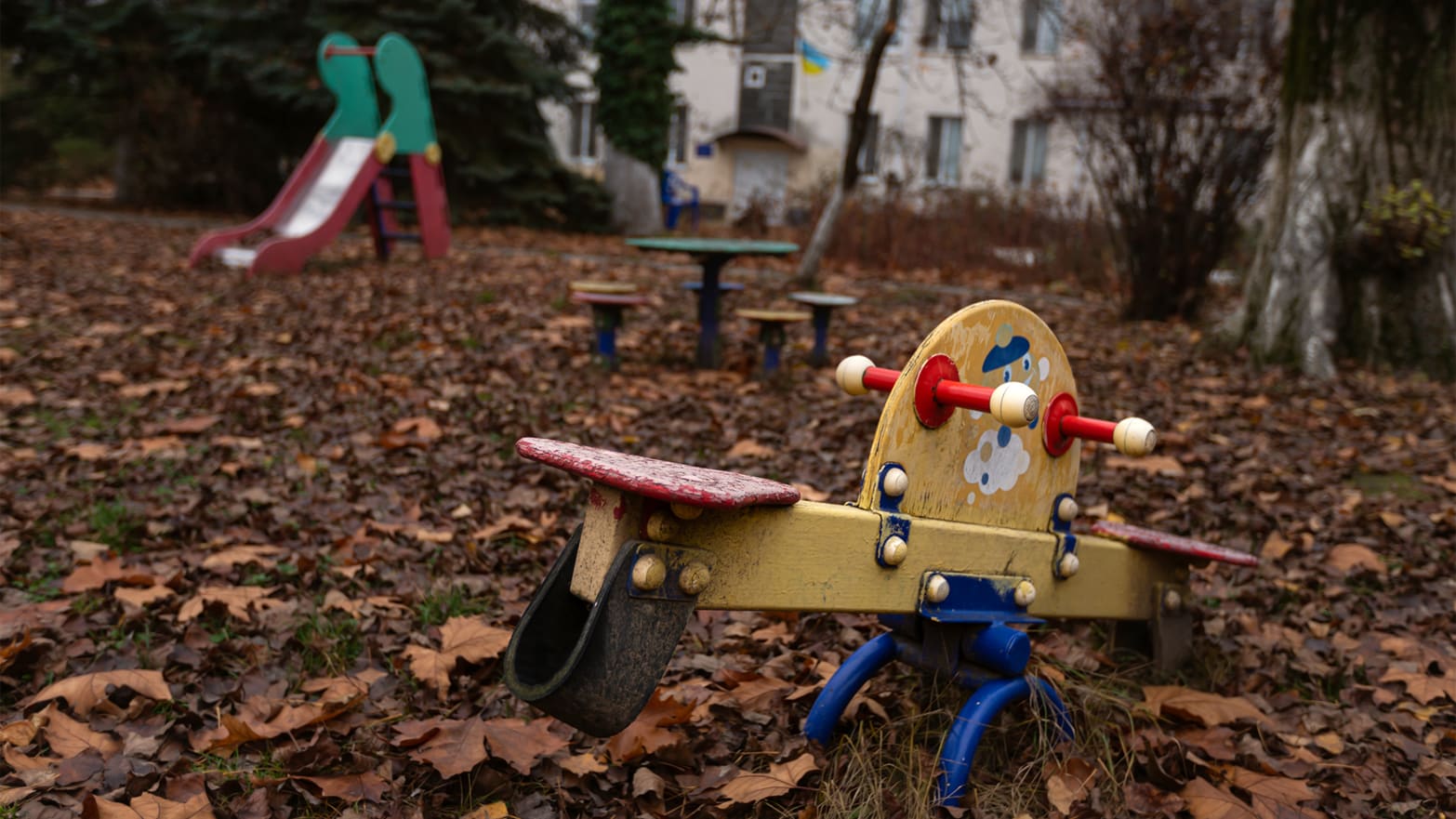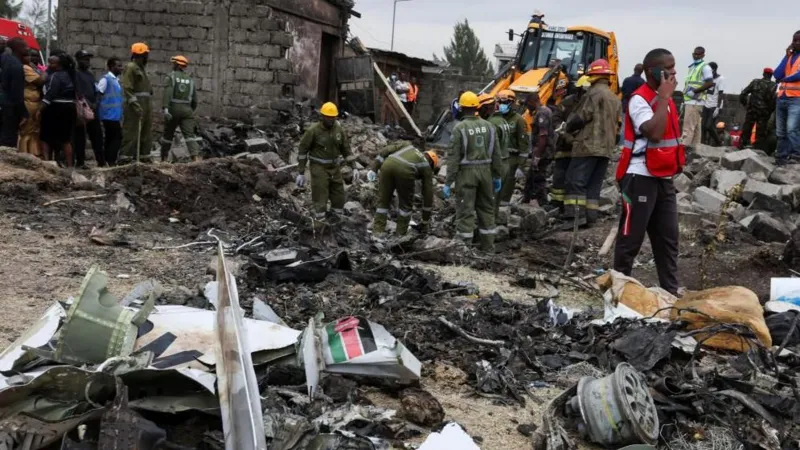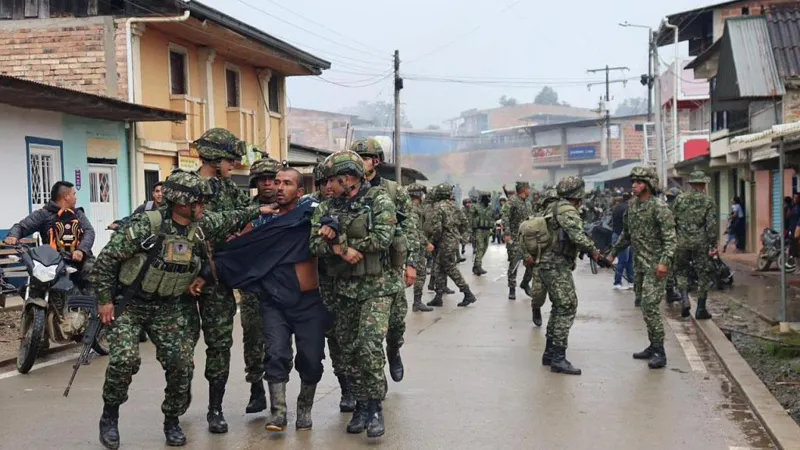How 46 Toddlers Were Disappeared by Putin in One Fell Swoop

KHERSON, Ukraine—In a northeastern corner of Kherson city, the red-roofed Kherson Regional Children’s Home lays quiet and abandoned. Partially buried beneath piles of fallen leaves in its yard, a footpath meanders between climbing gyms, carousels, and gazebos with murals of children painted on their walls. Tucked away in a corner of the yard is a pile of strollers and toy cars, sitting on top of old desks and folded baby fences.
Such relics serve as the only reminders that dozens of toddlers used to live and play here every day until only a few months ago. On Oct. 21, the Kherson Regional Children’s Home became one of the latest sites of a wide-ranging effort by Russian authorities across occupied Ukraine to forcibly transfer Ukrainian children to other Russian-controlled parts of the country and even to Russia itself, according to Yaroslav Yanushevych, Kherson’s pro-Ukrainian governor, who was among the first to report the news on Telegram, and the Ukrainian president's commissioner for children's rights.
ADVERTISEMENT
That day, Anastasia, a medical nurse and masseuse at the home, arrived at the home to find strange vehicles and people she did not recognize in front of the property.
“When I entered the premises, [another nurse] tells me ‘Probably today they will be deporting the children,’” Anastasia, who requested to use an alias for security reasons, told The Daily Beast.
Anastasia found a moment to slip out of the home before Russian authorities arrived to carry out the deportation. But a video of the event that was posted to Telegram by a Russian official in Kherson showed women taking young children out of the home and loading them onto two buses that were accompanied by ambulances, several men in fatigues including at least one heavily armed soldier, and a Russian political party official. The video shows the official kissing one of the children, and ends with the convoy of vehicles pulling out of the home’s gate, leaving the property empty.
The entrance to the children's home.
Daniel Brown
“They were like my family, the kids,” Anastasia said. “This day was full of horrors—simply a nightmare.”
A total of 46 children, all under the age of 5 and some with disabilities, were transferred from the children’s home in Kherson to Simferopol in occupied Crimea by Russian authorities, who claimed they were doing so to guarantee the children’s safety. A month earlier, two others were deported from the home to Moscow, according to former employees. It’s unclear if either group of children were transferred elsewhere afterward, and their whereabouts remain uncertain, employees said. Similar deportations have taken place across various parts of Russian-occupied Ukraine; according to Ukrainian authorities, over 13,000 children have been transferred out of Ukrainian territory since the war began. According to the Associated Press, many of these deported children have been given Russian citizenship and culturally Russified after being adopted by new, Russian families—a pattern that, according to experts, fits squarely within the definition of genocide under the Genocide Convention.
“They just want to destroy us and our children, everything they’re doing is so that we will not exist”
— Natalia, former head nurse at the home
But the Kherson Regional Children’s Home is unique. Having been recaptured by Ukraine on Nov.11, it remains the only children’s institution where such a forcible transfer of children took place so far that has since been retaken by Ukrainian forces, according to the country’s national security service, the SBU.
Interviews with the individuals who worked at the home, along with video and photo evidence, offer a unique window into the lead-up to the October deportation. Their testimony sheds light on Russian authorities’ alleged reorganization of the home’s administration, their efforts to justify the one-off transfer of two children from the home directly to Russia before the October deportation, and their apparent intent to rob children of their Ukrainian identity.
“They just want to destroy us and our children, everything they’re doing is so that we will not exist,” Natalia, the former head nurse at the home, who requested to only be quoted using her first name for security reasons, told The Daily Beast. “They did not take them out of love.”
Like in other instances of their forcible transfers of children, Russian forces in Kherson framed the deportation from the children’s home as a humanitarian mission, a claim that is undermined by the pattern of behavior that Russian authorities displayed in their interactions with staff at the children’s home.
Anna Nemtsova
Prior to the deportation itself, Natalia stated that Russian authorities indicated to staff that they wanted to take the children to a safe place before “the Nazis,” as Russian authorities refer to Ukrainians, began shelling the city. In a post on Telegram, President Vladimir Putin’s United Russia party identified the official seen in the video as Igor Kastyukevich, the head of the party’s branch in Kherson, who boasted that he had “saved” the children in his own post on the platform.
“A huge stone has fallen from my soul,” Kastyukevich said at the end of the video of the deportation. “Today the children will be in Crimea, God willing.”
Adults and children hiding in a bomb shelter during the early days of the 2022 Russian invasion of Ukraine.
Courtesy Natalia
The Kherson children’s home was not an orphanage but rather a foster home, and according to Natalia, Russian authorities made no effort to reconnect any of the children with their birth parents, some of whom were still living in the Kherson region. In addition, both Natalia and Anastasia recalled that the occupation authorities claimed the children would only be taken to Crimea for two weeks before being returned to Kherson—a promise they ultimately did not fulfill.
Although Russian authorities publicly claimed the transfer was organized to protect children from imminent fighting in the city, Anastasia said they had been discussing transferring the children to Crimea since nearly the beginning of their occupation of Kherson in spring.
After the war began in February, the staff of the children’s home decided to move the children to a nearby bomb shelter, before moving them again to the basement of a church in Kherson for safekeeping from Russian occupation authorities, who had entered the city in early March. On April 15 however, Russian soldiers discovered the children, and according to Anastasia, said they would take them back to the home and then transfer them to Crimea along with the staff. After the staff apparently refused to relocate to Crimea, the decision was made to keep the children in the home in Kherson instead.
Around this time, according to Anastasia, about half the staff of the home resigned to avoid working with Russian authorities, Natalia included, while others like Anastasia opted to stay behind. But Anastasia recounted how in the summer months, she heard rumors that the authorities were once again threatening to send the children to Crimea.
“They said to us, ‘If there will be too few employees, if everyone leaves, then we will have to take the kids away, straightaway,’” she said. “’We will take them to Crimea.’”
“They were all wonderful. We all loved them, and they all said ‘mama’ to us”
— Natalia, former head nurse at the children’s home
Soon enough though, according to Anastasia and Natalia, Russian authorities filled gaps left by the original staff with pro-Russian employees instead, including a new administrator and head nurse. From that point on, Anastasia said she and other staff had little say in goings-on at the home, and the two Russian collaborators communicated decisions to them only through proclamation.
In one particular episode that revealed much about how Russian authorities worked in concert with the new pro-Russian management at the home, two children at the home were reportedly deported from Kherson to Moscow under false pretenses weeks before the main transfer took place in October.
The incident, which was confirmed by both Natalia and Anastasia, took place in September after the Russian-installed director sent the two children to a hospital, even though, according to Natalia, both of them were in perfect health. She then arranged for them to be sent to a sanatorium in Moscow for additional care, stating that they would be returned after one month.
“When they deported these children, there were just soldiers in masks with weapons, and they took these children,” Natalia said, recalling what she had heard from staff who had continued working at the Kherson home. “When they put them in their vehicle, the older boy cried very much.”
“Time went by, and the children were not returned to us,” she added. “We don’t understand where these two children of ours were lost.”
Natalia said she suspects the children were taken to be adopted by a Russian family who she said had come to visit them while they were at the hospital in Kherson. The Associated Press has reported that such adoptions of Ukrainian children have been accompanied by efforts to remake them into ethnic Russian children by giving them Russian citizenship and sending them to “patriotic education” classes, which is a crime under international law.
-DB







